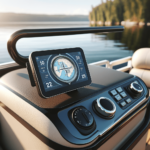Imagine spending a perfect summer day on a pontoon boat, enjoying the sun and the tranquility of the water. As you relax, you suddenly realize that your phone and other electronic devices are running low on battery. Panic sets in, but fear not! In this article, we will explore the possibility of charging your electronic devices on a pontoon boat. So sit back, relax, and let’s discover if you can stay connected while floating on the water.
Understanding Power Sources on a Pontoon Boat
When it comes to charging electronic devices on a pontoon boat, there are several power sources to consider. The two main options are battery power and generator power. Each has its own advantages and considerations, so it’s important to understand how they work and which option is the best fit for your needs.
Battery Power
Many pontoon boats are equipped with a battery system that can be used to power various devices onboard. These batteries are typically deep-cycle marine batteries, designed to provide a consistent and reliable source of power. They can be charged using the boat’s engine or through an external charging source.
Using the boat’s battery power to charge electronic devices is a convenient option, as it allows you to take advantage of the existing power system onboard. However, it’s important to keep in mind that using the boat’s battery for charging purposes can drain its power, potentially leaving you without sufficient power for other essential systems on the boat.
Generator Power
For those who require a more robust and reliable power source for charging their electronic devices, a generator can be a great solution. Generators are designed to provide a consistent flow of power and can be operated using gasoline, diesel, or propane.
One of the main advantages of using a generator is that it can provide a higher power output compared to the boat’s battery. This means that you can charge multiple devices simultaneously without worrying about draining the boat’s battery.
Another benefit of using a generator is that it can provide power for an extended period of time. This is particularly useful if you plan on spending long hours on the boat and need to keep your devices charged throughout the day.
Charging Options for Electronic Devices
Whether you choose to use the boat’s battery or a generator for powering your electronic devices, there are several charging options available to consider. These include using the boat’s battery directly, installing a power inverter, or using a portable generator.
Using the Boat’s Battery
Using the boat’s battery directly to charge your electronic devices is the simplest and most straightforward option. All you need to do is connect your devices to the battery using the appropriate charging cables or adapters. This method is ideal for charging devices that can be powered using a standard 12V DC power source.
To ensure efficient charging and to avoid draining the boat’s battery, it is important to monitor the battery levels regularly. Most pontoon boats have a battery gauge or a battery monitoring system that allows you to keep track of the battery’s charge.
Installing a Power Inverter
If you have devices that require AC power, such as laptops or larger appliances, installing a power inverter is a recommended option. A power inverter converts the boat’s DC power into AC power, allowing you to charge devices that require a standard wall outlet.
To install a power inverter, you will need to choose the right inverter based on your power requirements and the available space on your boat. The inverter is then wired into the boat’s electrical system and can be used to charge devices using the AC outlets it provides.
When using a power inverter, it’s important to keep in mind that it can draw a significant amount of power from the boat’s battery. This means that you should be mindful of the battery’s capacity and avoid overloading it by charging too many devices simultaneously.
Using a Portable Generator
Using a portable generator is another reliable option for charging electronic devices on a pontoon boat. Portable generators are compact, easy to transport, and can provide a higher power output compared to the boat’s battery.
To use a portable generator, you will need to select a suitable generator based on your power requirements. Make sure to choose a generator that is capable of providing enough power to charge all your devices simultaneously.
Connecting devices to a portable generator is usually straightforward, as most generators come with a variety of outlets, including standard AC outlets and USB ports. However, it’s important to manage fuel consumption and ensure you have enough fuel to run the generator for the desired duration.

Considerations for Charging Electronic Devices
When charging electronic devices on a pontoon boat, there are a few important considerations to keep in mind. These include the power consumption of your devices, the available charging ports, and safety precautions.
Power Consumption of Devices
Before charging your devices, it’s essential to consider their power requirements. Different devices have different power consumption levels, so it’s important to calculate the total power requirements to ensure you have enough power available.
To calculate the power requirements, you will need to determine the wattage of each device and add them together. This will give you an idea of how much power you need to provide and help you choose the appropriate charging method.
Available Charging Ports
Pontoon boats usually come equipped with various charging ports, including USB ports, 12V DC outlets, and AC power outlets. It’s important to consider which charging ports are available on your boat and whether they are compatible with your devices.
USB ports are suitable for charging smartphones, tablets, and other devices that can be powered using a USB cable. 12V DC outlets are ideal for devices that can be powered using a cigarette lighter adapter, such as portable fans or coolers. AC power outlets, on the other hand, provide the most versatility and can be used to charge devices that require a standard wall outlet.
Safety Precautions
When charging electronic devices on a pontoon boat, it’s important to take safety precautions to avoid any potential electrical hazards. Here are a few safety tips to keep in mind:
- Avoid overloading the electrical system by charging too many devices simultaneously. Make sure to distribute the power evenly and monitor the battery or generator’s capacity.
- Protect your devices from water damage by using waterproof or water-resistant cases. Avoid exposing your devices to direct contact with water or excessive moisture.
- If using a power inverter or generator, consider using surge protectors to safeguard your devices against power surges and fluctuations.
By following these safety precautions, you can ensure a safe and enjoyable charging experience for your electronic devices on a pontoon boat.
Conclusion
Charging electronic devices on a pontoon boat is certainly possible and can provide convenience and comfort during your boating adventures. Whether you choose to utilize the boat’s battery, install a power inverter, or use a portable generator, it’s important to understand the different power sources and charging options available.
Consider factors such as the power consumption of your devices, the available charging ports on your boat, and the safety precautions to ensure a smooth and worry-free charging experience. With the right knowledge and the appropriate equipment, you can keep your electronic devices powered up and ready to use while enjoying your time on the water.







